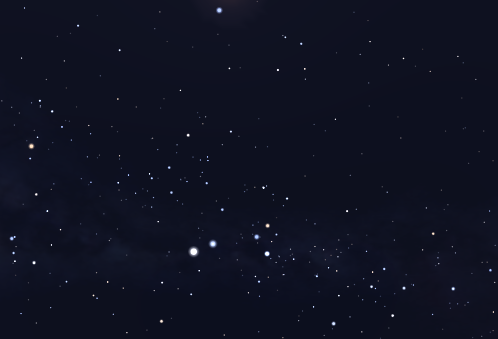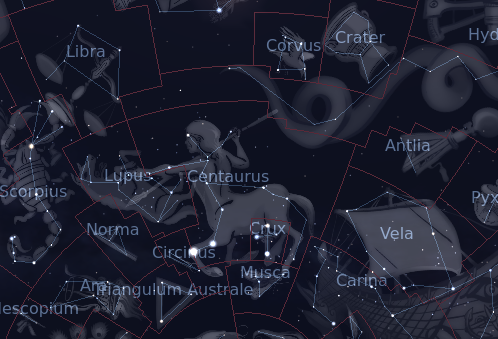The Constellation Centaurus
Centaurus is the ninth largest constellation, visible in the far southern sky in the months around March.
Visually, it is dominated by the bright stars α-Cen and β-Cen, which form a pair of pointers to the Southern Cross, Crux, and may be used to distinguish it from the False Cross asterism in Carina and Vela.
The brighter of these, α-Cen is not only the third brightest star in the sky but also the closest of all the stars visible to the unaided eye, lying at a distance of around 4.37 lightyears.
Although it appears as a single object to the unaided eye, it is actually a triple-star system. Through a telescope, it is easy to resolve into a pair of stars, of which HR 5459 is the brighter and HR 5460 the fainter. A third component of this system, Proxima Centauri, is the nearest known star to the Earth, but at 11th magnitude, it is very faint.
The Milky Way passes through the southern half of Centaurus, and so it is home to many bright open clusters. Its best known deep sky object is ω–Centauri (NGC 5139) which is the largest and brightest globular cluster in the sky, visible to the naked eye at mag 3.7.
In classical mythology, the centaurs were a race of beings who were half human and half horse. Centaurus is identified as one particularly wise centaur, Chiron, the son of Cronus, king of the Titans. He is commonly depicted holding an animal, the neighboring constellation Lupus, which he is about to sacrifice on the altar depicted in Ara.
Ancient
2.6% of the sky
1060.4 square degrees
Centaurus contains no Messier objects
Hover the pointer over the name of an object to highlight its position on the starchart to the right, or click to see more information.
| Stars | Open Clusters | Globular Clusters | Galaxies |
| Rigil Kentaurus (mag -0.0) | NGC 3766 (mag 5.3) | NGC 5139 (mag 3.6) | NGC 5128 (mag 7.0) |
| Hadar (mag 0.6) | NGC 5662 (mag 5.5) | NGC 5286 (mag 7.6) | NGC 4945 (mag 9.5) |
| α-Cen (mag 1.4) | NGC 5460 (mag 5.6) | NGC 5102 (mag 9.9) | |
| Menkent (mag 2.0) | NGC 5281 (mag 5.9) | NGC 4976 (mag 10.1) | |
| ε-Cen (mag 2.3) | NGC 5316 (mag 6.0) | NGC 5253 (mag 10.3) | |
| η-Cen (mag 2.3) | NGC 5617 (mag 6.3) | NGC 5206 (mag 10.5) | |
| δ-Cen (mag 2.5) | NGC 3680 (mag 7.6) | IC 4296 (mag 10.5) | |
| ζ-Cen (mag 2.5) | NGC 5138 (mag 7.6) | NGC 4936 (mag 10.7) | |
| ι-Cen (mag 2.7) | NGC 5606 (mag 7.7) | NGC 5419 (mag 10.8) | |
| γ-Cen (mag 2.8) | NGC 3960 (mag 8.3) | IC 4329 (mag 11.0) | |
| TYC8240-2724-2 (mag 2.9) | NGC 4852 (mag 8.9) | NGC 4709 (mag 11.1) | |
| λ-Cen (mag 3.1) | NGC 5168 (mag 9.1) | NGC 5483 (mag 11.1) | |
| κ-Cen (mag 3.1) | NGC 4230 (mag 9.4) | IC 3370 (mag 11.2) | |
| ν-Cen (mag 3.4) | IC 4291 (mag 9.7) | NGC 5090 (mag 11.3) | |
| μ-Cen (mag 3.4) | NGC 5120 (mag 10.8) | NGC 3706 (mag 11.3) | |
| φ-Cen (mag 3.8) | NGC 5381 | IC 3896 (mag 11.3) | |
| υ¹-Cen (mag 3.8) | NGC 5299 | NGC 5011 (mag 11.4) | |
| τ-Cen (mag 3.8) | NGC 5269 | IC 4214 (mag 11.4) | |
| σ-Cen (mag 3.9) | NGC 5043 | NGC 4930 (mag 11.4) | |
| π-Cen (mag 3.9) | IC 1023 | NGC 4767 (mag 11.5) | |
| d-Cen (mag 3.9) | NGC 3909 | NGC 5161 (mag 11.5) | |
| ρ-Cen (mag 3.9) | NGC 5121 (mag 11.6) | ||
| b-Cen (mag 4.0) | NGC 5408 (mag 11.6) | ||
| ψ-Cen (mag 4.0) | NGC 5193 (mag 11.7) | ||
| c¹-Cen (mag 4.1) | NGC 3882 (mag 11.8) | ||
| HIP 57439 (mag 4.1) | NGC 4835 (mag 11.8) | ||
| i-Cen (mag 4.2) | NGC 5026 (mag 11.8) | ||
| ξ²-Cen (mag 4.2) | NGC 4219 (mag 11.8) | ||
| n-Cen (mag 4.3) | NGC 5156 (mag 11.9) | ||
| V806 Cen (mag 4.3) | NGC 5333 (mag 11.9) |




